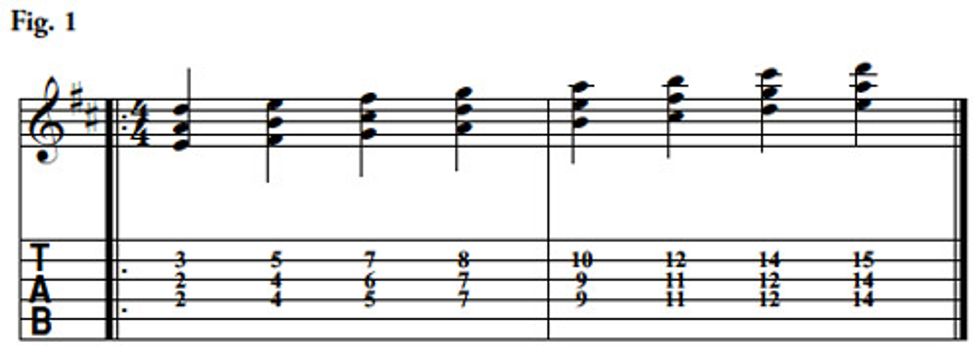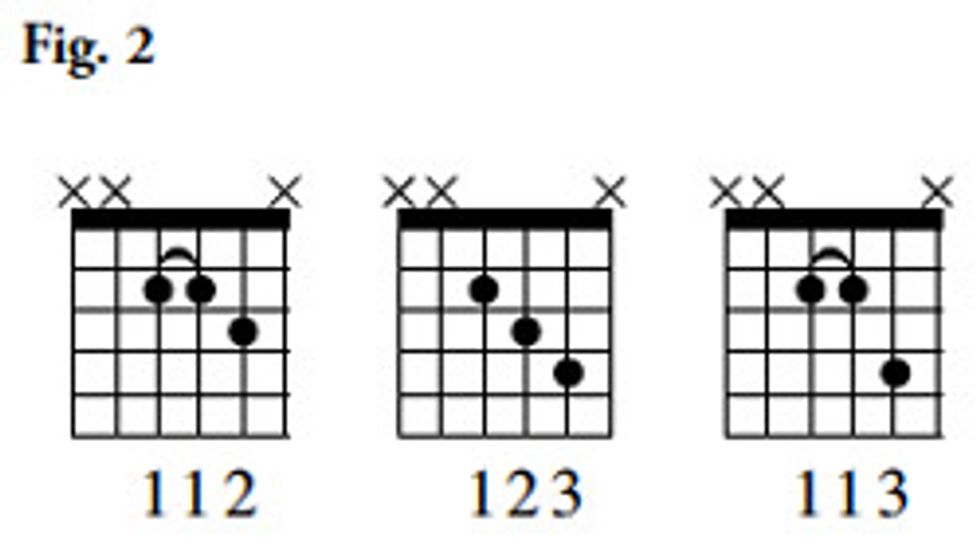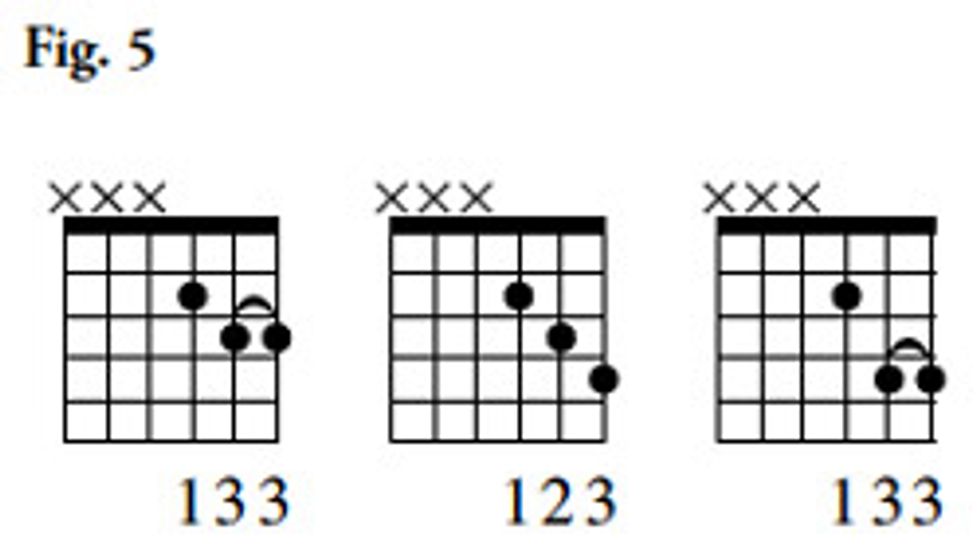In the previous three R&G columns, we
explored ways to play major and minor
triads as open-voiced forms. Using this
approach, we generated a slew of major
and minor chords that sound bigger than
standard-issue triads. (If you missed any of
these lessons, or want to refresh yourself on
the three voicing techniques we covered, go
to premierguitar.com and look for “Hybrid-Picking Pals,” “Going Up?,” and “Open for Business” in the January, February, and
March 2011 issues.)
This time around, we’re going to take
a radically different approach to building
chords. Rather than using major and
minor thirds—the intervals found in typical
chordal harmony—we’re going to use
fourths as our harmonic building blocks.
When you stack fourths to construct a
chord, you’re creating quartal harmony.
Jazz pianist McCoy Tyner—known
for his groundbreaking work with John
Coltrane—was one of the first to embrace
and popularize this technique in the ’60s.
Herbie Hancock and Chick Corea quickly
absorbed Tyner’s ideas and made quartal harmony
a fundamental element of jazz-rock.
Lenny Breau was a pioneer in applying these
sounds to jazz guitar, and today these fresh
and restless voicings appear in contemporary
bluegrass, blues, funk, and rock.
Chords voiced in fourths are neither
major nor minor, though they can often
be substituted for either chord type (we’ll
learn how to do this in subsequent lessons),
and they also work well in lieu of dominant
chords. Ambiguous yet versatile, quartal
voicings have the potential to greatly
expand your harmonic palette.
Getting started with quartal harmony
is easy enough: Simply pick a seven-note
major scale or mode, and then—staying
strictly within this tonality—stack a pair
of fourths on top of each scale tone. Each
fourth will be either perfect or augmented,
a choice that’s dictated by which scale tones
you’re working with at that moment.
Fig. 1 illustrates the process using E
Dorian (E–F#–G–A–B–C#–D) as our tonal
starting point. You can voice quartal chords
on any string set, but right now let’s keep
things simple by playing along strings 4, 3,
and 2. Take a minute to play just the bottom
note of each voicing, and you’ll see this
is an E Dorian mode that ascends for one
octave, a step at a time along the 4th string. Download Example Audio 1...

Now, go back to the beginning of bar 1 and slowly strum the first chord, which consists of two perfect fourths: E–A and A–D. Hey, welcome to the world of quartal harmony!
Next, play the second and third voicings in this example. When you hit the third grip, notice how the fingering changes. Why? To remain within E Dorian—the parent tonality we just established—we have to use an augmented fourth (G–C#) for the bottom interval. The chord’s top interval (C#–F#) remains a perfect fourth.
Work your way slowly up the neck, checking each chord carefully and listening to its edgy sound. When you reach the penultimate voicing (D–G–C#) at the 12th position, you’ll again find a new fingering. This time the augmented fourth is the higher of the two intervals. Finish up with the last form and then descend, strumming each form on the return journey. Try occasionally plucking the open 6th string to create an E drone against these descending chords. This will help you orient these voicings within the parent tonality.
Fig. 2 shows the three grips we just generated by stacking fourths in E Dorian on string set 4–3–2. In this example, we’re just visualizing the shapes. If you play them back to back, they’ll sound peculiar. Yet in a tonal context—that is, placed in their proper positions as dictated by the scale— these forms sound righteous. The first grid shows a pair of perfect fourths. The second is composed of an augmented fourth in the bottom and a perfect fourth on top. That relationship is flipped in the third grip, which consists of a perfect fourth topped by an augmented fourth. Download Example Audio 2...

Fig. 3 gives us an opportunity to put our newfound knowledge to work. Pick a moderate tempo and play this phrase about 10 times. It might take a few passes to acclimate to the sound of quartal harmony, but once your ear settles in, the effect can be hypnotic. If you have a looper, grab the four-bar section and then try jamming in E Dorian on top of the changes. Download Example Audio 3...

Let’s see what happens when we try a different tonality and string set. Fig. 4 shows a set of quartal voicings derived from A Mixolydian (A–B–C#–D–E–F#–G) and played on string set 3–2–1. Once again, calibrate your ear by playing the lowest note in each voicing, starting with A on the 3rd string and ascending one octave through A Mixolydian. Download Example Audio 4...

Then carefully work through the three-note voicings, absorbing both their sound and shape. You’ll find three forms when you do this, and they’re shown in Fig. 5. Study them and identify the combinations of perfect and augmented fourths lurking in each grip. It bears repeating: Played back to back, these forms sound downright bizarre—at least to my ears. But when you put them in a tonal context—as in the funky Fig. 6—you’re rewarded with beautiful harmonic textures.
Download Example Audio 5...
Download Example Audio 6...


We’ll continue exploring quartal harmony in the next lesson. Meanwhile, see if you can create some grooves of your own using the E Dorian or A Mixolydian voicings we’ve generated so far. If you find something you’re happy with, be sure to record it or loop it or teach it to a friend so you can start soloing on top of the progression in the corresponding mode.
 Andy Ellis is a veteran guitar journalist
and Senior Editor at PG. Based
in Nashville, Andy backs singer-songwriters
on the baritone guitar, and also
hosts The Guitar Show, a weekly on-air
and online broadcast. For the schedule,
links to the stations’ streams, archived audio
interviews with inspiring players, and more,
visit theguitarshow.com.
Andy Ellis is a veteran guitar journalist
and Senior Editor at PG. Based
in Nashville, Andy backs singer-songwriters
on the baritone guitar, and also
hosts The Guitar Show, a weekly on-air
and online broadcast. For the schedule,
links to the stations’ streams, archived audio
interviews with inspiring players, and more,
visit theguitarshow.com.

























